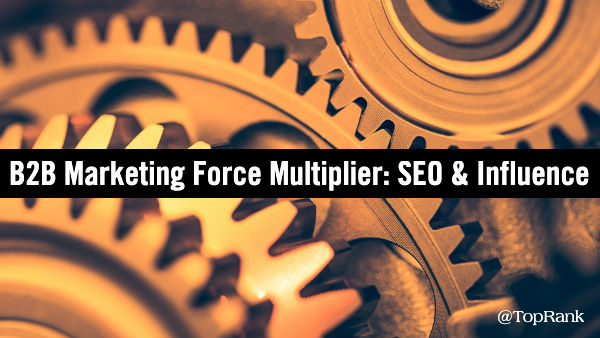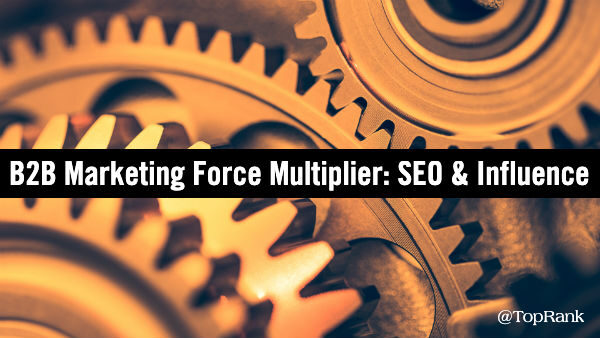
As business customers with questions are ignoring tone deaf brand marketing (and tiring of Pandemic messaging too) they are increasingly in search of information more than ever. Trust Radius reports that some B2B tech categories are seeing anywhere from 194% to 613% increases in search driven traffic. Search engines are clearly positioned to deliver answers for buyers seeking answers, but where is the trust? And more importantly, is your brand the best answer when and where buyers are looking?
SEO alone is not enough. A study from CSO insights ranked Web searches the 8th most trusted source of information for technology buyers. According to a study by Forbes/Yext, only 50% of customers believe search results. Search ads are not necessarily the solution because 65% of marketers don’t trust them either (HubSpot).
What good is being found in search if customers don’t trust what they find?
The solution? Make search optimized content more trustworthy, credible and useful by partnering with industry experts to create it. A Demand Gen Report study reports that 95% of buyers prefer influencer content. That’s an incredibly strong level of preference that B2B marketers would be negligent to ignore.
SEO and influence are excellent partners to deliver a satisfying content experience. To do that, you must first find the sweet spot for your customers with content that is findable with SEO and credible by showcasing relevant expertise from industry influencers.
Influencer content also optimizes B2B brands for Google E-A-T. Expertise, Authoritativeness and Trustworthiness are page quality characteristics highlighted in Google’s Search Quality Evaluator Guidelines. When B2B companies ensure their content demonstrates E-A-T characteristics, it’s akin to optimizing for both better Google and customers.
Credible Content Creation and Promotion can be a force multiplier for your marketing performance for multiple reasons. First, influential experts can extend the output of your marketing department by helping you make content. Second, those same experts can add credibility to brand content with quotes, insights on entirely influencer generated content. Third, the investment in content creation by those influential experts can also inspire them to promote that content to their trusted networks through social shares, inclusion in industry publications or cross published to influencer media (podcasts, livestream video, recorded video, blog posts, etc).
Like all marketing efforts, its important to identify your SEO and influencer marketing goals: improved organic search visibility, increased click through rates from Google to your site, improved time on site, increased click throughs from SEO landing pages to deeper content, and conversions referred from organic search.
Because influencers are involved, you can also benchmark and monitor the brand share of voice on social networks for the influencers you are working with, the social reach and impressions of their social shares, the referred traffic and conversions from their shares.
If the influencers you are working with publish their own content and you are able to engage them to cross-post or create original content aligned with your campaign, you can track the search visibility of your brand mentions on their websites. Doing so can help you manage achieving multiple positions within search results on the same query.
To help you get started towards realizing the marketing multiplier effect of integrated SEO and influencer marketing, here is a checklist of considerations in 5 sections:
Step 1 – Create Your Target Customer Profile
- Describe your customer – demographics, psychographics, firmographics
- What search keywords matter to this customer?
- Which types of influencers matter to this customer?
- What content topics and types are important for this customer?
- What questions does this customer want answered?
- Which social platforms does this customer use?
- Which publications, podcasts or “shows” does this customer subscribe to?
Step 2 – Identify Influencers for SEO Topics
- Leveraging SEO keyword research and an understanding of the content to be created/optimized, research 5-10 on-topic influencers using BuzzSumo, Traackr or other influencer marketing software.
- Identify influencers creating on-topic content with great search visibility (Consider influencers recognized by Google with a Knowledge Panel).
- Evaluate influencer’s link attraction rate when they publish or contribute content.
- Align search keywords and corresponding influencers with content intended to function at the appropriate stage in the customer journey: Top, Middle and Bottom of funnel.
Step 3 – Activate Influencers to C0-Create Optimized Content
- Use the Target Customer Profile to document specific content types and content sources (social platforms, media, blogs, newsletters, podcasts, YouTube channels etc) that matter to your customer.
- By topic, map relevant influencers to specific content assets for activation.
- Engage influencers and invite them to provide content for their assigned topics in the format preferred.
- Use SEO topics in influencer interview questions to inspire SEO-friendly answers.
Step 4 – Inspire Content Promotion & Links
- Identify opportunities to engage individual influencers for content promotion. Examples include: podcast, webinar, report contribution, social shares, quotes for blog posts, 3rd party editorial, newsletter or brand social channels.
- Create UTM codes for URLs of content provided to influencers to share so they can be tracked in your analytics.
- Provide influencer creators with topic clusters they can organically use in content and social shares.
- Identify pre-launch influencer engagement opportunities – provide prewritten social shares.
- Create an announcement blog posts, social promotions and engage influencers to create blog, video and social network content.
- Create a series of promotional emails.
- Support blog, social and earned media with targeted online advertising.
- Post launch, repurpose influencer content on brand social networks, blog and in contributed articles.
Step 5 – Implement Ongoing Optimization & Influencer Engagement
- Monitor the group of influencers you are working with for brand & keyword mentions on social networks and engage appropriately.
- Repurpose influencer quotes in ongoing content: newsletters, presentations, contributed articles to publications, ebooks, infographics, etc.
- Share updates with the influencers you are working with on the status of the campaign they participated in, updates to relevant technology or solutions and about your influencer program.
- Find ways to connect influencers with each other: host an influencer happy hour on Zoom, create a LinkedIn or Facebook group, create channel on Slack.
- Surprise and delight influencer contributors with feedback, tokens of appreciation and thank you’s.
- Consider providing influencers with SEO audits of their blogs so they can improve their organic search visibility.
Topics that drive SEO and topics that guide influencer identification and content collaboration are a natural fit and can expand the impact of your organic search visibility as well as the advocacy about your brand amongst trusted voices in your industry. As effective organic search visibility requires ongoing care and optimization, influencer relationships also require ongoing care and nurturing.
Organic SEO is a form of “always on marketing” that works 24/7 and a small ongoing investment can pay big dividends when your B2B brand content is presented by Google at the very moment the buyer is looking. The same optimism about influencers can be said when it comes to brand advocacy and a trusted industry expert organically recommends your brand.
I hope this checklist has provided you with some direction that will help you get started with a search optimized and integrated influencer marketing strategy. There are many levels of process, tools and deep expertise that can make implementing an effort like this successful in a reasonable amount of time. If you have any questions or need help, the masters of SEO and Influence at TopRank Marketing are happy to help! Visit our Influencer Marketing Services resources or contact us directly.



